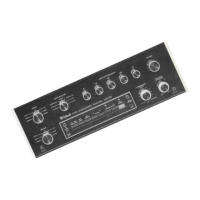
Do you have a question about the McIntosh C34V and is the answer not in the manual?
| Type | Preamplifier |
|---|---|
| Total Harmonic Distortion | 0.005% |
| Input Sensitivity (Phono) | 2.5mV |
| Signal-to-Noise Ratio (Phono) | 80 dB |
| Signal-to-Noise Ratio (High Level) | 90dB |
| Frequency Response | 20 Hz to 20 kHz |
| Input Sensitivity (High Level) | 250mV |
| Inputs | Phono, Tuner, Aux, Tape |
| Outputs | Tape |
Read, retain, heed, and follow instructions; avoid water, ensure ventilation, prevent entry of objects.
Proper power connection, cord protection, ventilation, heat avoidance, and grounding.
Locate antennas away from power lines and ground the system properly.
Handle damage requiring service, proper servicing, plug safety, and extension cord use.
Details coverage, authorized service, and transferability of the service contract.
Highlights dual preamps, input selectors, equalizer, loudness, filters, and compandor.
Guidance on placement for proper ventilation and heat dissipation.
Step-by-step instructions for custom panel cutouts and PANLOC mounting.
Instructions for installing mounting strips and PANLOC brackets.
How to slide the unit into the cabinet and lock it using PANLOC.
Connecting turntables, tuners, CDs, TVs, and VCRs/tape decks.
Connecting external processors and outputting audio signals.
Using the monitor amp and connecting the ground terminal.
Connecting the unit to AC power and identifying outlet types.
Guidelines for using AC outlets and fuse replacement.
Connecting accessories like SCR 2 and MVS-1.
Using Listen/Record selectors and the Mode selector for signal routing.
Adjusting the five-band equalizer and loudness contour for sound.
Introduction to the compandor for dynamic range control.
Details on compandor selector, ratio, level match, and speed settings.
Guide on using the compandor to expand dynamic range or reduce noise.
Guide on using the compandor to compress dynamic range for recording.
Usage examples for compandor and controls on the top panel.
Details on using the monitor amplifier with headphones and speakers.
Functions of Compandor, Record Equal, and Record Monitor pushbuttons.
Functions of LF/HF filters and Speaker/Output 1 & 2 pushbuttons.
How to turn the unit on and off using the power button.
Detailed specs for frequency response, output, distortion, sensitivity, and SNR.
Specs for monitor amp, semiconductors, AC outlets, and power requirements.
Size, finish, mounting type (PANLOC), and weight of the unit.
Charts showing compandor characteristics, level match, and input limits.
Graphs for frequency response, loudness control, and equalizer response.
Graphs for RIAA EQ, phono distortion, intermodulation distortion, and monitor amp specs.
Explains dual channels, phono amp design, and feedback networks.
Details electronic switching and the signal path for listening.
Describes the record path, EQ, compandor operation, and VCA.
Details the monitor amp, Power Guard, and turntable auto turn-on features.
Labels and references for all front panel controls and pushbuttons.
Labels for rear panel audio inputs, outputs, and processor jacks.